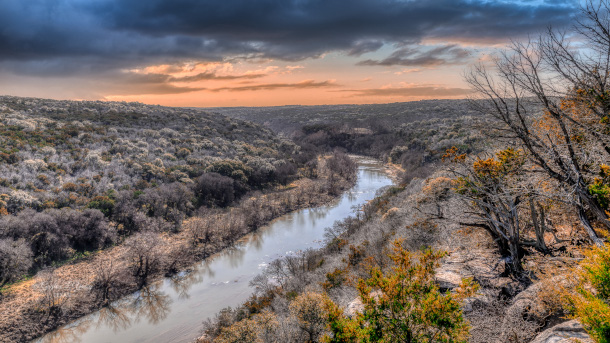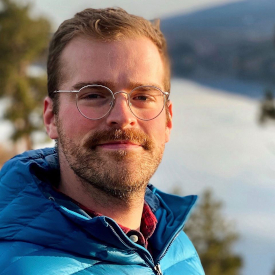Less Water for the Dry West
Air Date: Week of May 26, 2023

The Colorado River has been in a state of crisis due to warming weather and drought conditions. (Photo: G. Lamar, Flickr, CC BY 2.0)
The states that rely on the Colorado River for water are facing a supply crisis as climate change reduces the river’s flow. Now, after months of tense debates and delay, California, Arizona, and Nevada have finally agreed to substantially reduce their Colorado River water use, at least for now. KUNC reporter Luke Runyon joins Host Jenni Doering to explain the deal and the federal help these states will receive to ease some of the economic pain of cutting water use.
Transcript
CURWOOD: It’s Living on Earth, I’m Steve Curwood
DOERING: And I’m Jenni Doering.
40 million people rely on the Colorado River for drinking water, irrigation, and energy. But a mega-drought linked to climate disruption has severely reduced the river’s flow over the past few decades, leading to a crisis in recent months with two key reservoirs at dire lows. But the summer of 2022, the federal government for the first time instructed the states that rely on the Colorado River to come up with a plan to cut water use. And after months of tense debates and delay, California, Arizona and Nevada have finally agreed to substantially reduce water use, at least for now. Here to tell us more is Luke Runyon, who covers the Colorado River Basin for station KUNC in Greeley, Colorado and hosts their podcast, "Thirst Gap: Learning to live with less on the Colorado River." Welcome back to Living on Earth, Luke!
RUNYON: Hey, thanks for having me.
DOERING: So just how big of a deal is this agreement?
RUNYON: It's hugely important because you have California, Arizona and Nevada, stepping up to the plate and saying that they're ready to commit to a certain amount of conservation, and particularly for California, because they haven't always been eager to sign on to conservation agreements in the past, because they kind of hold this more senior position on the river. But really, what's being proposed right now is another short term deal and this is an attempt to get the rivers negotiators, the policymakers to 2026, which is when a current set of managing guidelines for the river expire, and what the kind of community of people who negotiate on the river we're really needing was some stability in how the river functions, because we've been in crisis mode for the past several years. And no one was able to think long term, all of these crises were kind of sucking up all of the oxygen in the room and not allowing people to be thinking long term. And so the way that they're building this new proposal is this is what is going to get us through to 2026.
DOERING: Right, so what exactly have the states agreed to and how are they going to cut their water usage?
RUNYON: So the states are putting forward 3 million acre feet in cuts over the next three years and one acre foot for those people who aren't, you know, water nerds is about the amount of water that supplies two average households for their annual water use in the Southwest. So it's a lot of water and each state is going to kind of be approaching this in a different way. So let's start with California, California, a lot of the water that's used in California is used for agriculture, and it's used in these large irrigation districts. And each Irrigation District is going to kind of be approaching this differently. And what makes this deal different than past agreements is that this conservation is being incentivized by more than a billion dollars in federal funding from the Inflation Reduction Act. So this isn't necessarily, you know, these mandatory cutbacks and when slamming a hammer down really this conservation is being incentivized with this federal money. And each state is going to kind of be taking a different tack. You know, in in Nevada, really a lot of the Colorado River use is in the Las Vegas metro area. That city has been tremendously proactive in coming up with conservation agreements and programs, you know, lawn buyback programs, investing in water recycling. So they say that they're pretty well positioned to take these cutbacks that are being proposed.
DOERING: So there's this $1.2 billion coming from the federal government to help ease some of this pain. To what extent do you think that is enough to soften the blow partially or even fully?

Reporter Luke Runyon covers the Colorado River basin for KUNC and 20+ NPR stations in the southwest. He also hosts KUNC’s podcast, “Thirst Gap: Learning to live with less on the Colorado River.” (Photo: Courtesy of Luke Runyon)
RUNYON: Well, I don't want to shake a stick at a billion dollars, because it sounds like an awful lot of money but, you know, I think we know that adapting to climate change is going to be a very costly process not just for the American Southwest when it comes to adapting to water scarcity but whether you're looking at rising seas along the coast or increasing natural disasters, I mean, these are events, these are trends that are going to be extremely costly to learn to live with. Whether that's coming in the form of paying farmers not to farm or making huge upgrades to water infrastructure. I mean, these projects add up really quickly and you can spend a billion dollars pretty easily in just a matter of a few months. So I think it's going to take a lot more money in order to try and make the region more resilient to climate change.
DOERING: Now, this is a proposal that Arizona, California and Nevada have all agreed to, when should we expect to start seeing these water cuts and how soon after that might we see results in the Colorado River itself?
RUNYON: Well, some of the states say that they're ready to start implementing this agreement right away, even though it still has to go through a federal review, there's still several hoops that this proposal would have to jump through before it's finalized. At least some of the people who negotiated say that they're not waiting, they know that the Colorado River needs this kind of conservation now, and they're ready to start implementing some of these cuts already. So I spoke with the chief negotiator on river issues for the state of California and he said, you know, now that we have this proposal in place, we're going to start pursuing some of these contracts with irrigation districts, that sort of thing in order to start implementing this right away. And, you know, there's the potential that that could start showing up in the Colorado rivers largest Reservoir, Lake Mead almost immediately, you know, if you stop taking water out, it stays in the reservoir and that has an immediate effect. But like I said, we still don’t know a lot of the details of exactly how much water when over the course of these three years, this is going to be taking place, how quickly this money is going to be going out. So we'll still kind of have to be watching over the next several months, several years to know exactly how this proposal is implemented.
DOERING: Now, I know that the American West had actually a very wet winter this year, we heard about these atmospheric rivers hitting California. To what extent did that factor into these discussions at all?
RUNYON: The wet winter was hugely important. We would as a region be having a very different conversation, if the Southwest had had just a slightly dry winter but we had a tremendous amount of snow in the Rocky Mountains and the Colorado River is snow fed and that factored into these negotiations in that they allowed some of the pressure to be eased on the people who were negotiating. I mean, the cuts that we were talking about last summer were huge. This is not that agreement, the cutbacks that are being proposed now are significantly less than what were put forward by federal officials last year saying this is what's necessary to save the Colorado River. This agreement is not that. And that's because everyone got this reprieve from mother nature in the form of a really wet winter.

Pictured is the White River National Forest in Colorado. Snowfall over the last year helped replenish the Colorado River’s water supply. (Photo: Sathish J, Flickr, CC BY-NC-ND 2.0)
DOERING: Luke, what do you see as the next steps in the process of protecting this watershed?
RUNYON: Now that this proposal is on its way too, being finalized. All of the discussion is going to be on these post 2026 managing guidelines for the river. And a lot of the hard conversations, hard discussions, a lot of the big swirling unanswered questions on the river everyone has been putting those off until this moment, because all of the focus of the conversation has been on managing this crisis, managing the emergency. And hopefully with this agreement coming together now, those policymakers can actually sit down and talk about what the future of this watershed really looks like. Hopefully, it won't be in such an emergency mode and you can talk about how you go about answering all these big questions about how do you go about reducing demand. How do you better include stakeholders in the process of managing this river? Whether that's tribal nations, whether that's the country of Mexico, whether that's the environmental community recreation groups. How do you go about creating a more inclusive process to manage this river? Those are conversations that are going to be had now because this new proposal has come together.
DOERING: Luke Runyon is a reporter with KUNC in Greeley Colorado, who covers the Colorado River Basin. Luke, thank you so much for taking this time with me today.
RUNYON: Yeah, thanks for having me.
Links
The Washington Post | “States Reach Deal with Biden To Protect Drought-Stricken Colorado River”
Luke Runyon’s podcast with KUNC, “Thirst Gap: Learning to live with less on the Colorado River”
Living on Earth wants to hear from you!
Living on Earth
62 Calef Highway, Suite 212
Lee, NH 03861
Telephone: 617-287-4121
E-mail: comments@loe.org
Newsletter [Click here]
Donate to Living on Earth!
Living on Earth is an independent media program and relies entirely on contributions from listeners and institutions supporting public service. Please donate now to preserve an independent environmental voice.
NewsletterLiving on Earth offers a weekly delivery of the show's rundown to your mailbox. Sign up for our newsletter today!
 Sailors For The Sea: Be the change you want to sea.
Sailors For The Sea: Be the change you want to sea.
 The Grantham Foundation for the Protection of the Environment: Committed to protecting and improving the health of the global environment.
The Grantham Foundation for the Protection of the Environment: Committed to protecting and improving the health of the global environment.
 Contribute to Living on Earth and receive, as our gift to you, an archival print of one of Mark Seth Lender's extraordinary wildlife photographs. Follow the link to see Mark's current collection of photographs.
Contribute to Living on Earth and receive, as our gift to you, an archival print of one of Mark Seth Lender's extraordinary wildlife photographs. Follow the link to see Mark's current collection of photographs.
 Buy a signed copy of Mark Seth Lender's book Smeagull the Seagull & support Living on Earth
Buy a signed copy of Mark Seth Lender's book Smeagull the Seagull & support Living on Earth

